Dragon fruit farming is growing rapidly, but farmers often face challenges that are difficult to identify, especially when plants show unusual symptoms. One such problem is caused by tiny pests called Nematodes in Dragon Fruit plants, which can seriously harm your dragon fruit plants during the growing season. This article will help you understand what nematodes are, how to recognize their signs, and the best ways to control them so your plants stay healthy and productive.
What Are Nematodes in Dragon Fruit plants?
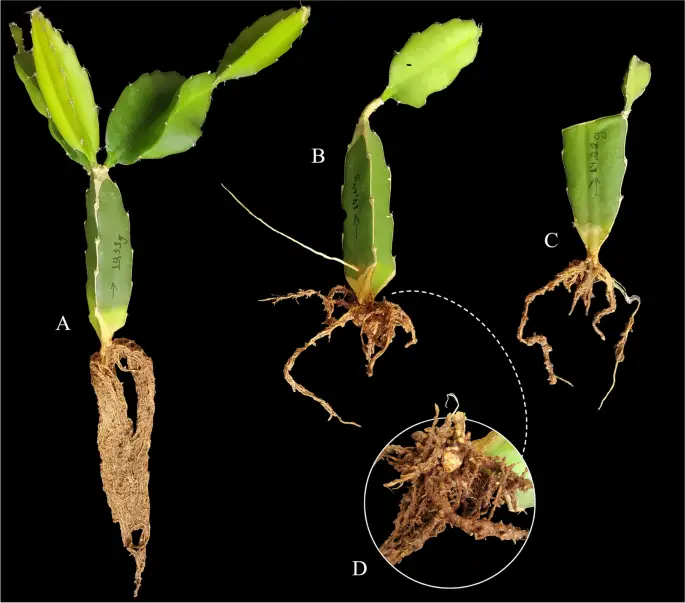
Nematodes in Dragon Fruit plants are tiny, thread-like worms living mostly in the soil. They are so small that you cannot see them with your naked eyes. Some nematodes are harmless, but many types are harmful pests that attack plant roots.
- They live inside the soil and enter the roots of plants.
- They are often called “root-knot nematodes” because they cause knots or galls (swollen lumps) on the roots.
- These nematodes feed on the roots by sucking out nutrients, which weakens the plant.
- When nematodes attack, they reduce the plant’s ability to absorb water and nutrients.
In dragon fruit farming, nematode infestation is a common problem, especially if proper soil care and plant health management are not followed.
Signs of Nematode Infestation in Dragon Fruit Plants
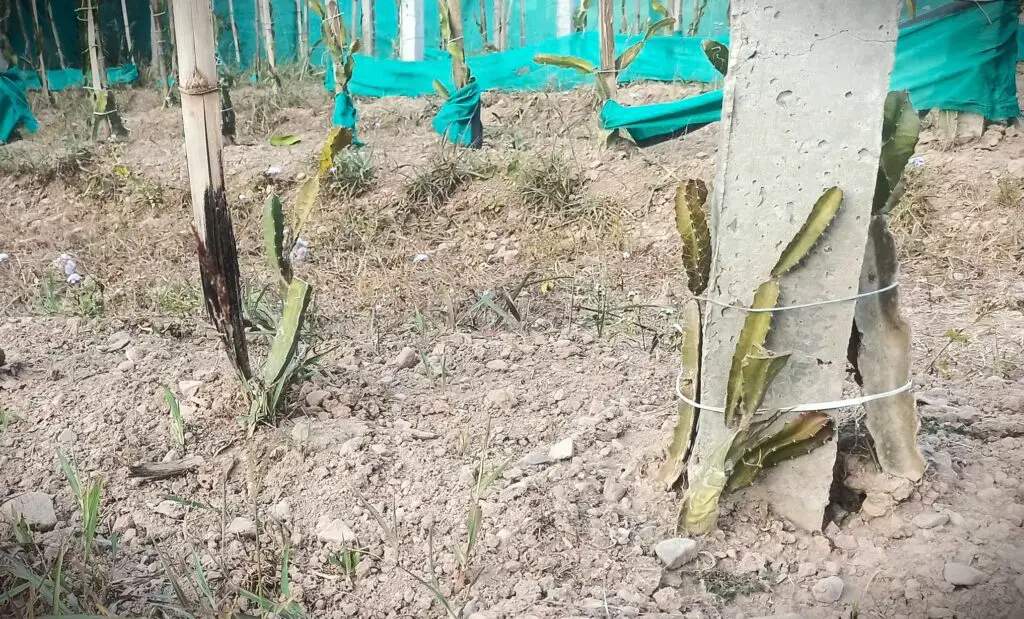
It is important to identify nematode problems early to save your plants and ensure good fruit production. Look for these common signs:
1. Yellowing Leaves
- Leaves start turning yellow but may be mistaken for sunburn or nutrient deficiency.
- Check roots carefully before applying any treatment because yellow leaves can mislead farmers.
2. Root Galls or Knots
- Roots develop small, abnormal lumps or swellings called galls.
- These galls reduce the root’s efficiency in absorbing nutrients and water.
3. Slow Growth
- Infected plants grow slowly compared to healthy ones.
- They appear weak and less vigorous.
4. Root Rot
- Damaged roots may begin to rot and decay because of nematode damage.
- This can eventually kill the plant if untreated.
5. Reduced Fruit Production
- Plants produce fewer fruits, and the fruits may be smaller and of poor quality.
6. Poor Soil Health
- Soil with Nematodes in Dragon Fruit plants infestation may affect other crops too because nematodes multiply quickly and spread.
How to Prevent and Control Nematodes in Dragon Fruit Plants
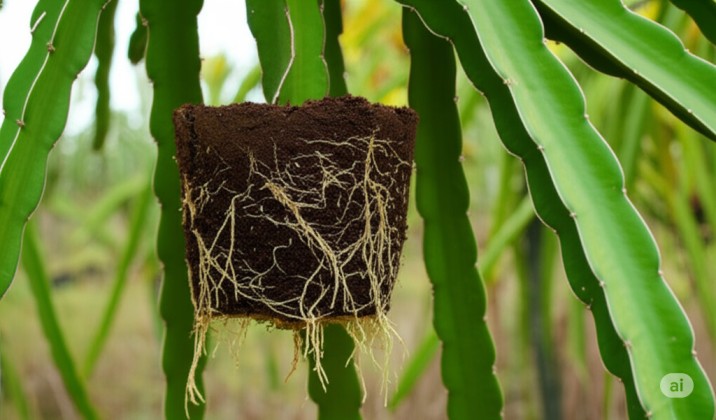
How to control nematodes in dragon fruit – Taking the right steps to control nematodes will protect your dragon fruit plants and improve your harvest.
1. Regular Soil Testing
- Collect soil samples from your field periodically.
- Testing helps detect nematode presence early before serious damage occurs.
2. Soil Solarization
- Cover soil with clear plastic sheets during hot months to use sunlight to kill nematodes and other pests.
- This process heats the soil and reduces pest population naturally.
3. Use Organic Treatments
- Apply organic materials such as neem cake and bio-fertilizers like Trichoderma fungus.
- These help control nematodes biologically without harming the environment.
4. Grow Companion Plants
- Plant marigold (Tagetes) around your dragon fruit field.
- Marigold roots produce substances that prevent nematodes from attacking.
5. Select Healthy Plants
- Use disease-free and nematode-free planting material.
- Avoid planting infected or weak seedlings.
6. Manage Irrigation and Drainage
- Avoid waterlogging because excess water encourages nematode spread.
- Maintain proper watering schedules and ensure good drainage.
7. Crop Rotation
- Rotate your dragon fruit with other crops that are not hosts to nematodes.
- This practice helps reduce nematode numbers in the soil.
8. Use Chemical Nematicides Carefully
- If organic methods are not enough, use chemical nematicides under expert guidance.
- Follow recommended doses strictly to avoid damage to plants and soil.
9. Field Hygiene
- Remove and destroy infected plants and root debris from the field.
- Clean tools and equipment to prevent spreading nematodes.
10. Balanced Nutrition
- Provide plants with balanced fertilizers to keep them strong and resistant.
- Healthy plants can better tolerate nematodes treatment in Dragon Fruit plants attacks.
Organic Control Agent: Paecilomyces lilacinus
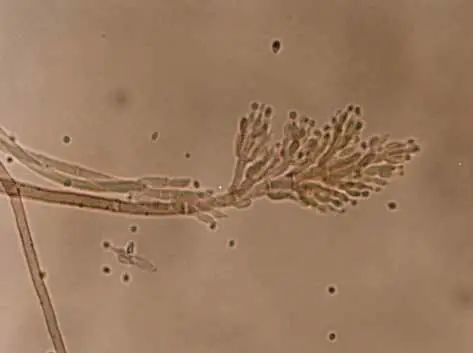
Paecilomyces lilacinus is a helpful fungus found naturally in soil. It is used as a biological control agent against nematodes.
How to control nematodes in dragon fruit
- Attacks nematode eggs and larvae by breaking their protective layers.
- Reduces nematode population naturally without harming plants or soil life.
Benefits
- Environmentally friendly and safe for farmers.
- Reduces dependency on chemical nematicides.
- Improves crop yield and quality.
How to Use
- Mix it into soil near plant roots.
- Soak seeds in a solution containing this fungus before planting.
- Apply with irrigation water to cover affected plants.
Important Notes
- Always follow usage instructions and recommended doses.
- Avoid mixing it with chemical pesticides that can kill this beneficial fungus.
Tip of the Day for New Dragon Fruit Farmers
Early Detection and Prevention Is the Key
Always inspect your plants regularly, especially their roots, whenever you notice yellowing leaves or slow growth. Don’t rush to apply treatments without proper diagnosis. Soil testing before planting and during the growing season can save your crop from severe Nematodes in Dragon Fruit plants damage. Use organic methods like neem cake and Paecilomyces lilacinus early on for long-term benefits. Remember, healthy plants and clean fields reduce pest problems significantly.
Frequently Asked Questions (FAQs)
1. Can nematodes affect dragon fruit plants at any growth stage?
Yes, nematodes can attack dragon fruit plants at any stage after planting. Early precautions are important to protect young and mature plants alike.
2. How can I tell if yellow leaves are due to nematodes?
Yellow leaves may look like sunburn or nutrient deficiency. Check the roots for galls or knots to confirm nematode infestation.
3. Is there a natural way to control nematodes?
Yes, using biological agents like Paecilomyces lilacinus and organic amendments like neem cake helps control nematodes naturally.
4. What is soil solarization and how does it help?
Soil solarization is covering moist soil with transparent plastic during hot weather. It heats the soil, killing nematodes and other harmful organisms.
5. Can marigold plants really protect dragon fruit from nematodes?
Yes, marigold roots produce chemicals that repel nematodes, reducing their population in the soil.
6. When should chemical nematicides be used?
Only use chemical treatments when organic and cultural methods fail, and always under expert advice to avoid harming plants and soil.
7. How often should I test my soil for nematodes?
Test the soil before planting and once or twice during the growing season to catch early infestation.
8. What happens if nematodes are left untreated?
Untreated nematodes weaken roots, reduce water and nutrient uptake, stunt plant growth, and lower fruit yield and quality.
9. How does crop rotation help manage nematodes?
Rotating with non-host crops breaks the nematode life cycle, reducing their population in the soil over time.
10. Are there any risks in using Paecilomyces lilacinus?
When used as directed, it is safe and effective. Avoid mixing with harmful chemicals that can reduce its effectiveness.
If you follow these guidelines carefully, your dragon fruit plants will stay healthy, productive, and nematode-free, ensuring a successful harvest season
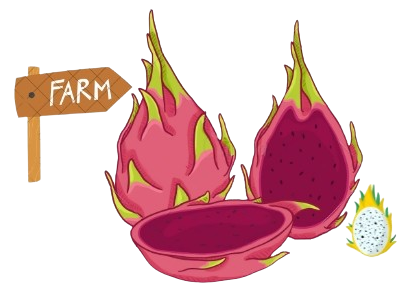

1 thought on “Nematodes in Dragon Fruit Plants and How to Control Them?”